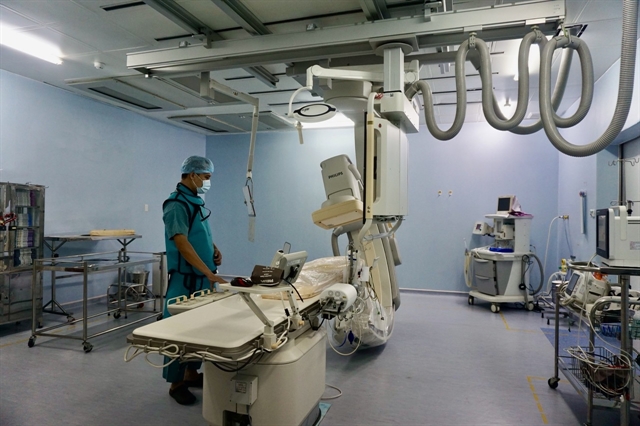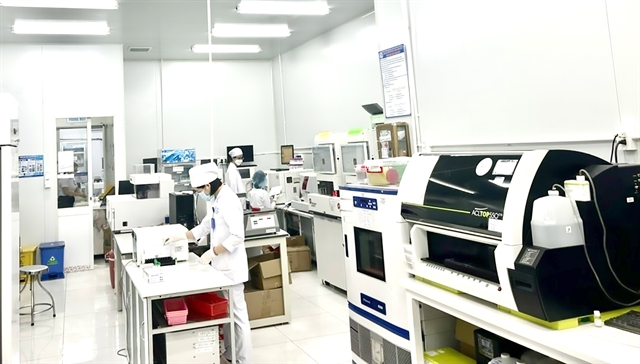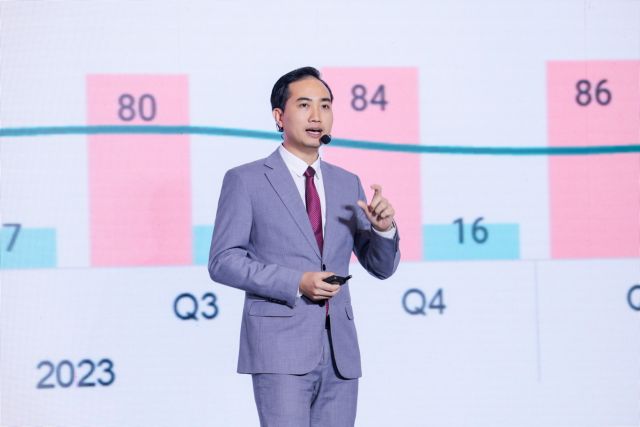 Society
Society


|
| Bình Chánh District Hospital is equipped with modern equipment and devices. VNS Photo Thu Hằng |
Thu Hằng
HCM CITY — District-level hospitals in HCM City have invested extensively in infrastructure, state-of-the-art devices and human resources and adopted advanced techniques to improve the quality of healthcare.
Thủ Đức City Hospital, a district-level general hospital, receives more than 4,000 outpatients and admits 500-600 inpatients every day.
It has adopted advanced techniques for intensive care, cardiology, oncology, and stroke with assistance from doctors at city-level hospitals, according to Dr Hoàng Văn Dũng, its deputy director.
It has streamlined administrative procedures and digitised most documents and medical records, providing convenience to patients and reducing their waiting time.
Patients could use the VssID app launched by Vietnam Social Security to replace health insurance cards, and use an appointment app to visit the hospital.
The hospital uses artificial intelligence (AI) for diagnostic imaging, and will continue to adopt new techniques and embrace digital transformation to further improve quality.
Lê Kim Loan, 64, who suffers from multiple ailments including hypertension, diabetes, atherosclerosis, and arthritis, visits the facility every month.
She said: “I have been getting health examination and treatment at the hospital for 10 years. I enjoy a health insurance coverage rate of 95 per cent and pay the remaining 5 per cent.
“As I live in Thủ Đức City, it is convenient for me to get regular care and treatment instead of travelling to city-level hospitals. It does not take long for diagnostic tests and I trust the care and treatment here.”
Bình Chánh District Hospital in the city’s outlying district offers health check-up and treatment for 1,600 out-patients and 250-300 in-patients every day or 90 per cent of its capacity, according to Phạm Nguyễn Anh Vũ, its deputy director.
The 340-bed hospital, built in 2018 and with modern equipment and devices, serves locals and also people from neighbouring provinces.
Last year it adopted many cutting-edge technologies and new medical techniques such as interventional cardiovascular procedures, coronary angiogram and pacemaker implantation.
Its rehabilitation and cosmetic surgery units opened last year.
The hospital often sends doctors and nurses for training, invites specialists from major hospitals and medical universities to assist with examination and treatment and trains its staff in advanced medical techniques.
This year it will open departments for artificial kidneys, urology surgery and stroke, and set up a new zone for outpatients with the assistance of experts working at city-level hospitals.
It targets becoming a first-grade hospital this year.

|
| An elderly patient receives health check-ups at Thủ Đức City Hospital. VNS Photo Thu Hằng |
New facilities
A new general hospital each are under construction in Thủ Đức City and Củ Chi and Hóc Môn districts, and they promise to improve healthcare in outlying districts and reduce overcrowding at major city hospitals.
Expansion of the 3.1-hectare Nhà Bè District Hospital began in late 2022 at a cost of VNĐ460 billion (US$18.6 million), including VNĐ170 billion ($6.9 million) for equipment and devices. It will have two new buildings with 200 beds while the existing building with 100 beds will be refurbished.
Around 85 per cent of the construction has been completed.
The 1,000-bed Củ Chi Regional General Hospital, being built at a cost of VNĐ1.8 trillion ($72.9 million), is expected to be completed next quarter.
Construction of the 1,000-bed VNĐ1.9 trillion ($77.1 million) Thủ Đức Regional General Hospital is almost completed, and it is expected to open this year. —VNS

|
| The Haematology and Blood Transfusion Department at Thủ Đức City Hospital is equipped with modern equipment and devices. VNS Photo Thu Hằng |




